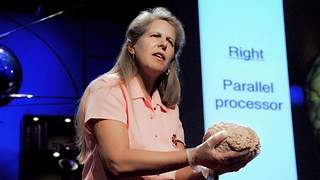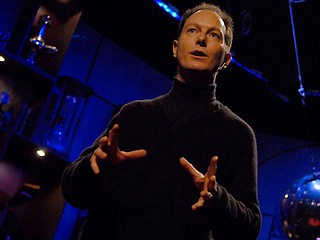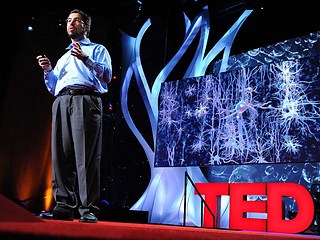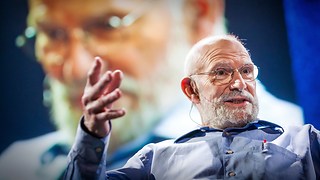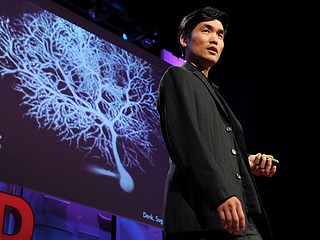Introductory essay
Written by the educators who created Mapping and Manipulating the Brain, a brief look at the key facts, tough questions and big ideas in their field. Begin this TED Study with a fascinating read that gives context and clarity to the material.
Here is this mass of jelly, three-pound mass of jelly you can hold in the palm of your hand, and it can contemplate the vastness of interstellar space. It can contemplate the meaning of infinity and it can contemplate itself contemplating on the meaning of infinity.VS Ramachandran
The brain may well be our body's most mysterious organ. Unbelievably complex, utterly fascinating, and notoriously difficult to study, we're left wondering: What exactly does the brain do and how does it do it?
Despite two centuries of intensive research, supported in recent decades by impressive technological advances, answers to many of our questions about the brain are still distant. The reason is easy to appreciate: the brain contains more than ten billion cells — a number equivalent to the total human population on Earth — interacting with each other through about 1,000 times as many connections. Imagine that what's going on in your brain is like a shrunk-down version of the global human population interacting through the Internet. The Internet is hard enough to understand even though we created it; now imagine trying to understand a process of similar complexity without the benefit of knowing how it was generated!
As you listen to these TEDTalks and expand your study of neuroscience through other sources, remember that although we might now know a great deal more about the brain than we did at the start of the 19th century, it's a tiny fraction of what there is to know. Bear in mind that many current ideas may prove wrong. Indeed, it's the excitement of generating and testing, and trying to prove or disprove ideas that might explain the great unknown inside our heads that motivates many research neuroscientists around the world.
A brief history of brain science
The Egyptians wrote the first known descriptions of the brain and its anatomy about 3700 years ago, but another 1200 years elapsed before Greek philosophers of the Hippocratic School identified the brain as the organ responsible for our cognitive functions. Around 400 B.C., Hippocrates declared, "Men ought to know that from the brain, and from the brain only, arise our pleasures, joy, laughter and jests, as well as our sorrows, pains, griefs, and tears." However, not everyone agreed: although Plato and Hippocrates thought that the brain was responsible for sensation, intelligence and mental processes, Aristotle believed it was the heart.
Over the next 2500 years, the work of great European intellectuals including Galen of Bergama, Leonardo da Vinci and Rene Descartes improved our understanding of the brain. By the start of the 19th century, the brain's importance as the organ of perception and higher mental function was beyond doubt.
In the early 1800s, scientists made an important conceptual breakthrough when they hypothesized that different brain functions are carried out in specific and distinct brain regions. Brain regionalization, a concept central to several of the TEDTalks we'll watch, remains an important though controversial component of modern neuroscience.
Some of the initial models of brain regionalization were severely misguided, mainly because they were built on little or no evidence. For example, the Viennese physician Franz Joseph Gall (1758-1828) became convinced for the flimsiest of reasons that each of mankind's mental faculties, including our moral and intellectual capabilities, are each controlled by a separate "organ" within the cerebral hemispheres of the brain. The pseudo-science of phrenology that grew out of Gall's claims gained an enormous popular following in the 19th century; advocates believed that skilled practitioners could feel the lumps and bumps on an individual's skull to gain information about the underlying "organs" and thus fully describe the individual's personality and mental abilities.
Although phrenology is now discredited, the fundamental idea that different functions are localized to different areas of the brain turned out to have merit — even if Gall got the details wrong. The story of phrenology also provides a salutary lesson on the dangers of accepting popular beliefs about aspects of brain function and dysfunction that are difficult to critically evaluate through scientific experimentation. Even today, it's common to find that people think they know more than it's currently possible to know about how and why brains work or go wrong; for example, the causes and cures for various types of mental illness, which may contribute to the social stigma that surrounds these conditions.
Through the late 19th and early 20th centuries, scientists including Pierre Paul Broca, Carl Wernicke, Korbinian Brodmann and Wilder Penfield found credible scientific evidence supporting the subdivision of the brain into discrete areas with different specific functions. Their work was based on studies of patients with localized lesions of the brain, of the anatomical differences between different parts of the brain and of the effects of stimulating discrete brain regions on bodily actions. Together, scientists such as these laid the foundations of modern neuroscience. As you watch the TEDTalks in Mapping and Manipulating the Brain, notice how the speakers reference some of the same approaches used by Broca, Wernicke, Brodmann and Penfield, and how they apply the concepts of brain regionalization and localization of function . Bear in mind, however, that although these concepts are useful, they're also controversial -- more on this below.
How brains are built
Spanish scientist Santiago Ramón Y Cajal (1852-1934) is often thought of as the father of modern neuroscience. Through his extensive and beautiful studies of the microscopic structure of the brain, he discovered that the neuron is the fundamental unit of the nervous system. Since Ramón Y Cajal's breakthrough, scientists have sought to understand how the billions of neurons in the brain are organized to support so many complex functions.
This daunting task would likely be easier if we could follow the process by which the brain is generated, but following brain development is very difficult to do in humans. Thus, we often have to infer how the human brain develops by studying the developing brains of other species, so-called "model organisms" selected for their particular advantages in certain experimental procedures. Aside from helping us to work out how the adult brain functions, research on brain development is a major area in neuroscience for other reasons as well. For example, many conditions like schizophrenia and autism can be traced back to abnormalities in earlier brain development.
The great molecular, structural and functional diversity of brain cells, along with their specializations and precise interactions, are acquired in an organized way through processes that build on differences between the relatively small numbers of cells in the early embryo. As more and more cells are generated in a growing organism, new cells diversify in specific ways as a result of interactions with pre-existing cells, continually adding to the organism's complexity in a highly regulated manner. To understand how brains develop we need to know how their cells develop in specific and reproducible ways as a result of their own internal mechanisms interacting with an expanding array of stimuli from outside the cell.
Since, as discussed above, regionalization is a prominent organizing feature in mature brains, when and how is it established during brain development? Some of the most exciting research on brain development in recent years has focused on this question.
For neurons to develop regional identities, they must possess or acquire information on where they are located within the brain so that they can take on the appropriate specializations. How neurons gain positional information has been one of the most prominent themes in developmental neuroscience in the last 50 years or so, as indeed it has in the broader field of developmental biology (positional identity is required not only by brain cells).
The model that has dominated current thinking was famously elaborated in the 1960s by Lewis Wolpert in his French flag analogy. Here, a signal produced by a group of organizer cells diffuses from its source through a surrounding field of cells. In so doing, it forms a concentration gradient with more of the signal present in areas closer to the source. Cells respond to the concentration of this signal. In Wolpert's French Flag analogy, they become blue, white or red (in reality, they would become cells of different types, not different colors). Close to the source, cells receive signals above the highest threshold (to become blue, or type 1). Beyond this, cells respond to a lower dose (to become white, or type 2) while farther still cells do not receive enough of the signal to respond (and become red, or type 3). Here the model is expressed in terms of three outcomes, but there might be a different number of outcomes depending on the locations and/ or stages of development. The important point is that cells can work out where they are based on the level of signal they receive and they respond accordingly by developing different attributes.
Beyond Wolpert's basic model, the issue of how brain regionalization develops is an important question and we have relatively few answers. Regional specification is a prerequisite for the development of the connections that must link each region of the brain in a stereotypical and highly precise way (but allowing room for plasticity at a fine level). How these trillions of connections are made is another of life's great mysteries.
The connectome and connectionism
Since Ramón Y Cajal's first description of the neuron, scientists have vastly expanded our understanding of the structure and function of these individual building blocks of the brain. However, as Tim Berners-Lee comments, this is just the first step in understanding how our brains really work: "There are billions of neurons in our brains, but what are neurons? Just cells. The brain has no knowledge until connections are made between neurons. All that we know, all that we are, comes from the way our neurons are connected."
You'll hear about the "connectome" in Sebastian Seung's TEDTalk. The suffix "–ome" is used with increasing frequency to indicate a complete collection of whatever units are specified in the first part of the word, such as genes (hence genome), proteins (proteome) or connections (connectome). The connectome of the human brain is bewildering in its complexity, but the development of new brain imaging methods has catalyzed the first serious attempts to map it in living brains. At present, the resolution of imaging methods that can be applied to living brains isn't sufficient to follow individual connections (called axons). In these TEDTalks you'll hear about an attempt to come at the problem from the other direction, using very high resolution imaging of non-living brain tissue to reconstruct the ultramicroscopic anatomy of connections around individual cells. The extent to which these approaches are likely to succeed remains controversial.
The theory known as connectionism addresses a somewhat different matter within the field of brain organization: the relationship between connectivity and function. Essentially, the idea is that higher mental processes such as object recognition, memory and language result from the activity of the connections between areas of the brain rather than the activity of specific discrete regions. Whereas connectionists would agree that primary sensory and motor functions (i.e. responses to sensory stimuli and the activation of movements) are strongly localized to defined areas within the brain, they argue that this applies less clearly at higher cognitive levels. The theory emphasizes the relationship between connected brain areas and the function of the brain as a whole, with all parts having the potential to contribute to cognitive function. You should appreciate, therefore, that there is as yet no accepted view of the extent to which our higher mental functions are localized to particular parts of the brain. It is worth remembering this as you listen to the TEDTalks; keep an open mind on these truly fascinating issues.
Ways of studying brain function
In these TEDTalks, you're going to hear about some of the ways in which we can work out what the human brain does and how it does it. One longstanding approach is to examine what happens when people suffer brain lesions. Phineas Gage, a Vermont railroad worker, provides one spectacular historical example from 1848. Gage was packing gunpowder into a hole when it exploded, blowing the tamping rod through the front of his brain. Astonishingly, he survived and recovered, but those closest to him claimed that he had a very different personality. From this example, scientists hypothesized that elements of human personality are localized to the frontal lobes.
In Jill Bolte Taylor's TEDTalk, you'll hear how Taylor's own stroke provides further evidence for localization of brain function. A few words of caution, however: when we study the effects of a lesion on the brain, we're really learning about what the rest of the brain does without the damaged part, which is not quite the same as what the damaged structure itself does. Maybe this seems rather subtle, but in some cases it becomes important, for example if a lesion causes other parts of the brain to alter what they do.
You'll also hear about powerful techniques for observing the activity of living brains, for example using functional magnetic resonance imaging (FMRI; see the TEDTalk by Oliver Sacks). And you'll hear about methods for looking at the fine structure of neurons in post-mortem material, as in Sebastian Seung's TEDTalk. All have advantages and limitations, but together they give ever- increasing insight into the workings of the human mind.
Let's begin the TEDTalks with neuroanatomist Jill Bolte Taylor, who provides a basic overview of the brain and describes what she learned firsthand about its structure and function when at age 37 she suffered a massive hemorrhage in the left hemisphere of her brain.
Relevant talks
